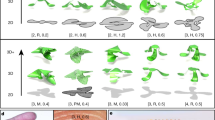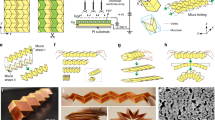Abstract
A self-powering nanosystem that harvests its operating energy from the environment is an attractive proposition for sensing, personal electronics and defence technologies1. This is in principle feasible for nanodevices owing to their extremely low power consumption2,3,4,5. Solar, thermal and mechanical (wind, friction, body movement) energies are common and may be scavenged from the environment, but the type of energy source to be chosen has to be decided on the basis of specific applications. Military sensing/surveillance node placement, for example, may involve difficult-to-reach locations, may need to be hidden, and may be in environments that are dusty, rainy, dark and/or in deep forest. In a moving vehicle or aeroplane, harvesting energy from a rotating tyre or wind blowing on the body is a possible choice to power wireless devices implanted in the surface of the vehicle. Nanowire nanogenerators built on hard substrates were demonstrated for harvesting local mechanical energy produced by high-frequency ultrasonic waves6,7. To harvest the energy from vibration or disturbance originating from footsteps, heartbeats, ambient noise and air flow, it is important to explore innovative technologies that work at low frequencies (such as <10 Hz) and that are based on flexible soft materials. Here we present a simple, low-cost approach that converts low-frequency vibration/friction energy into electricity using piezoelectric zinc oxide nanowires grown radially around textile fibres. By entangling two fibres and brushing the nanowires rooted on them with respect to each other, mechanical energy is converted into electricity owing to a coupled piezoelectric–semiconductor process8,9. This work establishes a methodology for scavenging light-wind energy and body-movement energy using fabrics.
This is a preview of subscription content, access via your institution
Access options
Subscribe to this journal
Receive 51 print issues and online access
$199.00 per year
only $3.90 per issue
Buy this article
- Purchase on Springer Link
- Instant access to full article PDF
Prices may be subject to local taxes which are calculated during checkout




Similar content being viewed by others
References
Paradiso, J. A. & Starner, T. Energy scavenging for mobile and wireless electronics. Pervasive Comput. 4, 18–27 (2005)
Li, Y., Qian, F., Xiang, J. & Lieber, C. M. Nanowire electronic and optoelectronic devices. Mater. Today 9, 18–27 (2006)
Tian, B. et al. Coaxial silicon nanowires as solar cells and nanoelectronic power sources. Nature 449, 885–890 (2007)
Javey, A., Guo, J., Wang, Q., Lundstrom, M. & Dai, H. J. Ballistic carbon nanotube field-effect transistors. Nature 424, 654–657 (2003)
Chen, J. et al. Bright infrared emission from electrically induced excitons in carbon nanotubes. Science 310, 1171–1174 (2005)
Wang, X. D., Song, J. H., Liu, J. & Wang, Z. L. Direct-current nanogenerator driven by ultrasonic waves. Science 316, 102–105 (2007)
Wang, X. D., Liu, J., Song, J. H. & Wang, Z. L. Integrated nanogenerators in biofluid. Nano Lett. 7, 2475–2479 (2007)
Wang, Z. L. & Song, J. H. Piezoelectric nanogenerators based on zinc oxide nanowire arrays. Science 312, 242–246 (2006)
Song, J. H., Zhou, J. & Wang, Z. L. Piezoelectric and semiconducting coupled power generating process of a single ZnO belt/wire: A technology for harvesting electricity from the environment. Nano Lett. 6, 1656–1662 (2006)
Hsu, J. W. R. et al. Directed spatial organization of zinc oxide nanorods. Nano Lett. 5, 83–86 (2005)
Gao, Y. F. & Wang, Z. L. Electrostatic potential in a bent piezoelectric nanowire: The fundamental theory of nanogenerator and nanopiezotronics. Nano Lett. 7, 2499–2505 (2007)
Gao, P. X., Song, J. H., Liu, J. & Wang, Z. L. Nanowire piezoelectric nanogenerators on plastic substrates as flexible power sources for nanodevices. Adv. Mater. 19, 67–72 (2007)
Wu, Y. L., Tok, A. I. Y., Boey, F. Y. C., Zeng, X. T. & Zhang, X. H. Surface modification of ZnO nanocrystals. Appl. Surf. Sci. 253, 5473–5479 (2007)
Liu, J. et al. Carrier density and Schottky barrier on the performance of DC nanogenerator. Nano Lett. 8, 328–332 (2008)
Acknowledgements
This research was supported by the DOE, the NSF, and Emory-Georgia Tech CCNE funded by the NIH.
Author Contributions Z.L.W., X.W. and Y.Q. designed the experiments; Y.Q. and X.W. performed the experiments; and Z.L.W. and X.W. analysed the data and wrote the paper. All authors discussed the results and commented on the manuscript.
Author information
Authors and Affiliations
Corresponding author
Supplementary information
Supplementary Information
The file contains Supplementary Figures S1-S8 with legends and Supplementary Notes. (PDF 1173 kb)
Supplementary Movie
This file contains Supplementary Movie 1. The movie relates to the experimental procedures described in the text. (MOV 4310 kb)
Rights and permissions
About this article
Cite this article
Qin, Y., Wang, X. & Wang, Z. Microfibre–nanowire hybrid structure for energy scavenging. Nature 451, 809–813 (2008). https://doi.org/10.1038/nature06601
Received:
Accepted:
Issue Date:
DOI: https://doi.org/10.1038/nature06601
This article is cited by
-
Tunable and parabolic piezoelectricity in hafnia under epitaxial strain
Nature Communications (2024)
-
Flexible piezoelectric coatings on textiles for energy harvesting and autonomous sensing applications: a review
Journal of Coatings Technology and Research (2023)
-
Effect of poling and excess Bi2O3 on piezocatalysis by BaBi4Ti4O15
Journal of Materials Science: Materials in Electronics (2023)
-
Smart textiles for self-powered biomonitoring
Med-X (2023)
-
Local modulation of electrical distributions in bent PS fibers via multi-segmented layered structures
Acta Mechanica (2023)
Comments
By submitting a comment you agree to abide by our Terms and Community Guidelines. If you find something abusive or that does not comply with our terms or guidelines please flag it as inappropriate.



